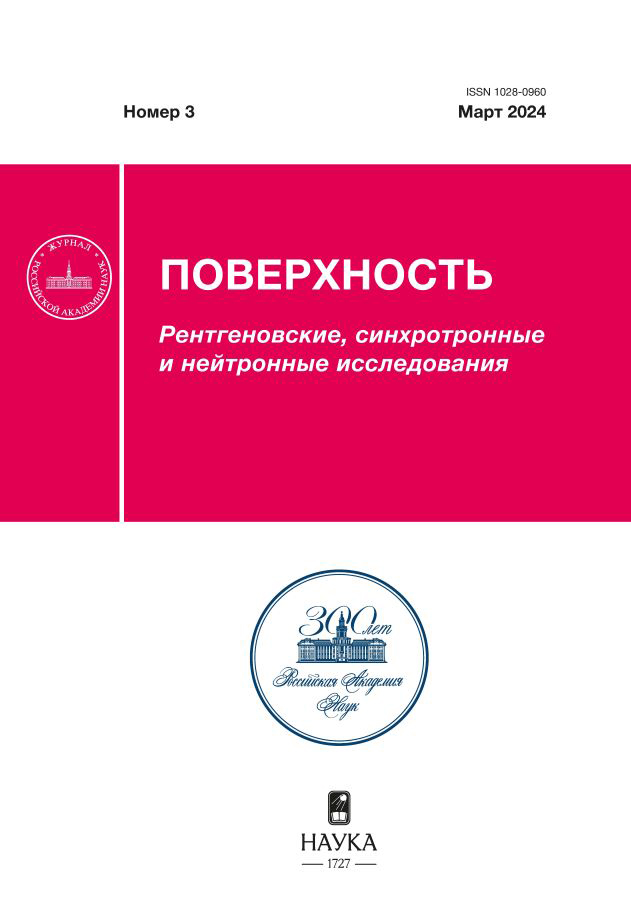Manifestation of the hexatic phase in confined two-dimensional systems with circular symmetry
- 作者: Nikonov E.G.1,2,3, Nazmitdinov R.G.1,3, Glukhovtsev P.I.1,3
-
隶属关系:
- Joint Institute for Nuclear Research
- National Research University Higher School of Economics
- Dubna State University
- 期: 编号 3 (2024)
- 页面: 10-18
- 栏目: Articles
- URL: https://kazanmedjournal.ru/1028-0960/article/view/664665
- DOI: https://doi.org/10.31857/S1028096024030021
- EDN: https://elibrary.ru/hgbboa
- ID: 664665
如何引用文章
详细
Quasi-two-dimensional systems play an important role in the manufacture of various devices for the needs of nanoelectronics. Obviously, the functional efficiency of such systems depends on their structure, which can change during phase transitions under the influence of external conditions (for example, temperature). Until now, the main attention has been focused on the search for signals of phase transitions in continuous two-dimensional systems. One of the central issues is the analysis of the conditions for the nucleation of the hexatic phase in such systems, which is accompanied by the appearance of defects in the Wigner crystalline phase at a certain temperature. However, both practical and fundamental questions arise about the critical number of electrons at which the symmetry of the crystal lattice in the system under consideration will begin to break and, consequently, the nucleation of defects will start. The dependences of the orientational order parameter and the correlation function, which characterize topological phase transitions, as functions of the number of particles at zero temperature have been studied. The calculation results allows us to establish the precursors of the phase transition from the hexagonal phase to the hexatic one for N = 92, 136, 187, considered as an example.
全文:
作者简介
E. Nikonov
Joint Institute for Nuclear Research; National Research University Higher School of Economics; Dubna State University
编辑信件的主要联系方式.
Email: e.nikonov@jinr.ru
俄罗斯联邦, 141980, Dubna; 119048, Moscow; 141980, Dubna
R. Nazmitdinov
Joint Institute for Nuclear Research; Dubna State University
Email: e.nikonov@jinr.ru
俄罗斯联邦, 141980, Dubna; 141980, Dubna
P. Glukhovtsev
Joint Institute for Nuclear Research; Dubna State University
Email: e.nikonov@jinr.ru
俄罗斯联邦, 141980, Dubna; 141980, Dubna
参考
- Bedanov V.M., Peeters F.M. // Phys. Rev. B. 1994. V. 49. № 4. P. 2667. https://doi.org/10.1103/PhysRevB.49.2667
- Koulakov A.A., Shklovskii B.I. // Phys. Rev. B. 1998. V. 57. № 4. P. 2352. https://doi.org/10.1103/PhysRevB.57.2352
- Mughal A., Moore M.A. // Phys. Rev. E. 2007. V. 76. Iss. 1. P. 011606. https://doi.org/10.1103/PhysRevE.76.011606
- Fortov V., Ivlev A., Khrapak S., Khrapak A., Morfill G. // Phys. Rep. 2005. V. 421. P. 1. http://dx.doi.org/10.1016/j.physrep.2005.08.007
- Soni V., Gόmez L.R., Irvine W.T.M. // Phys. Rev. X. 2018. V. 8. P. 011039. https://doi.org/10.1103/PhysRevX.8.011039
- Binks B.P., Horozov T.S. Colloidal Particles and Geometry in Condensed Matter Physics. Cambridge: Cambridge University Press, 2006. 503 р. http://dx.doi.org/10.1017/CBO9780511536670.002
- Leunissen M.E., van Blaaderen A., Hollingsworth A.D., Sullivan M.T., Chaikin P.M. // Proc. Natl. Acad. Sci. 2007. V. 104. № 8. P. 2585. https://doi.org/10.1073/pnas.0610589104
- Birman J.L., Nazmitdinov R.G., Yukalov V.I. // Phys. Rep. 2013. V. 526. P. 1. https://doi.org/https://doi.org/10.1016/j.physrep. 2012.11.005
- Wigner E.P. // Phys. Rev. 1934. V. 46. P. 1002. https://doi.org/10.1103/ PhysRev.46.1002
- Bonsall L., Maradudin A.A. // Phys. Rev. B. 1997. V. 15. P. 1959. https://doi.org/10.1103/PhysRevB.15.1959
- Nelson D.R. Defects and Geometry in Condensed Matter Physics. Cambridge: Cambridge University Press, 2002. 392 р.
- Рыжов В.Н., Тареева Е.Е., Фомин Ю.Д., Циок Е.Н. // УФН. 2017. Т. 187. № 9. С. 921. https://doi.org/10.3367/UFNe.2017. 06.038161
- Березинский В.Л. // ЖЭТФ. 1970. Т. 59. С. 900. https://doi.org/10.1103/PhysRevLett.39.1201
- Березинский В.Л. // ЖЭТФ. 1971. Т. 61. С. 1144.
- Kosterlitz J.M., Thouless D.J. // J. Phys. C. 1972. V. 5. Р. L124. https://doi.org/10.1088/0022-3719/6/7/010
- Kosterlitz J.M. // J. Phys. C. 1974. V. 7. P. 1046. http://dx.doi.org/10.1088/ 0022-3719/7/6/005
- Gann R.C., Chakravarty S., Chester G.V. // Phys. Rev. B. 1979. V. 20. P. 326. https://doi.org/10.1103/PhysRevB.20.326
- Kong M., Partoens B., Peeters F.M. // Phys. Rev. E. 2003. V. 67. P. 021608. https://doi.org/10.1103/PhysRevE.67.021608
- Cerkaski M., Nazmitdinov R.G., Puente A. // Phys. Rev. E. 2015. V. 91. P. 032312. https://doi.org/10.1103/PhysRevE.91.032312
- Nazmitdinov R.G., Puente A., Cerkaski M., Pons M. // Phys. Rev. E. 2017. V. 95. P. 042603. https://doi.org/10.1103/PhysRevE.95.042603
- Никонов Э.Г., Назмитдинов Р.Г., Глуховцев П.И. // Компьютерные исследования и моделирование. 2022. Т. 14. № 3. С. 609. https://doi.org/10.20537/ 2076-7633-2022-14-3-609-618
- Nikonov E.G., Nazmitdinov R.G., Glukhovtsev P.I. // J. Surf. Invest. X-ray, Synchrotron Neutron Tech. 2023. V. 17. № 1. Р. 235. https://doi.org/10.1134/S1027451023010354
- Frenkel D., Smit B. Understanding Molecular Simulation: From Algorithms to Applications. Academic Press, 2001. 661 р.
- Halperin B.I., Nelson D.R. // Phys. Rev. Lett. 1978. V. 41. P. 121. https://doi.org/10.1103/PhysRevLett.41.121
- Ландау Л.Д. // ЖЭТФ. 1973. Т. 7. С. 627.
- Ландау Л.Д., Лифшиц Е.М. Теория упругости. М.: Физматлит, 2003. 264 с.
- Nelson D.R., Halperin B.I. // Phys. Rev. B. 1979. V. 19. P. 2457. https://doi.org/10.1103/PhysRevB.19.2457
- Young A.P. // Phys. Rev. B. 1979. V. 19. P. 1855. https://doi.org/10.1103/PhysRevB.19.1855
- Fortune S. // Algorithmica. 1987. V. 2. P. 153. https://doi.org/10.1007/ BF01840357
- Peeters F.M. // Two-Dimensional Electron Systems / Ed. Andrei E.Y. Dordrecht: Kluwer Academic, 1997. P. 17.
- Lai Y.-J., I Lin // Phys. Rev. E. 1999. V. 60. P. 4743. https://doi.org/10.1103/PhysRevE.60.4743
补充文件













